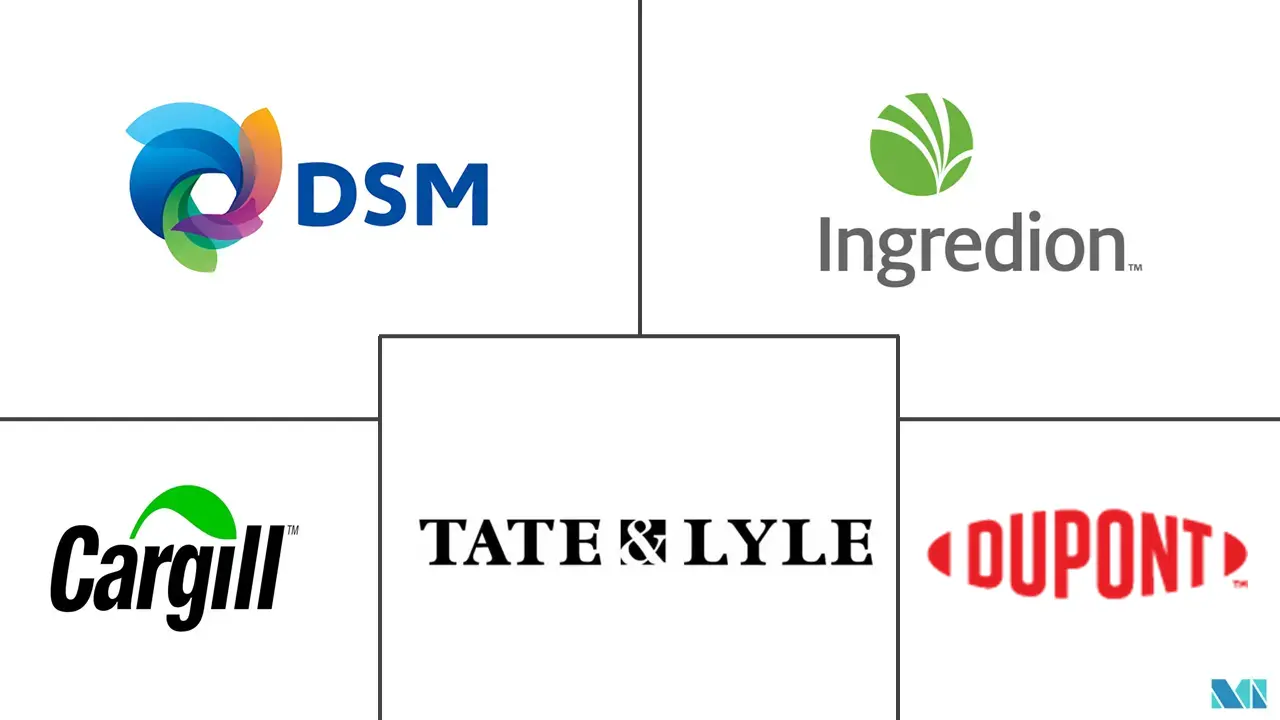Edible Films and Coating Market Size and Share
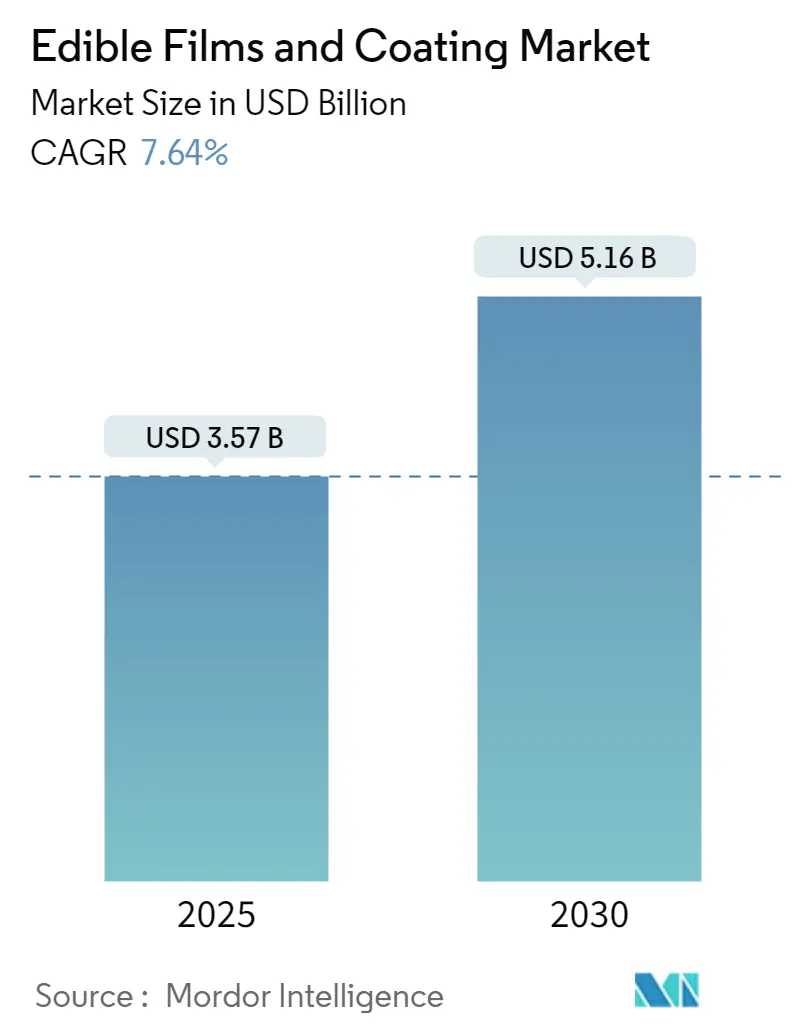
Edible Films and Coating Market Analysis by Mordor Intelligence
The Edible Films and Coating Market size is estimated at USD 3.57 billion in 2025, and is expected to reach USD 5.16 billion by 2030, at a CAGR of 7.64% during the forecast period (2025-2030).
- The benefit of using edible coating on food products is that it acts as a barrier for carbon dioxide, lipids, moisture, oxygen, and aromas. It improves food quality and extends the shelf life of products. One major advantage of using edible films and coatings is that several active ingredients can be incorporated into the polymer matrix and consumed with food, thus, enhancing safety or even nutritional and sensory attributes. The edible coatings can be made from soybean protein, wheat gluten, whey, gelatin, and many more.
- Demand for plant-based food products is increasing among consumers because of their benefits and health consciousness. The food product manufacturers have increased their efforts to increase the shelf life and improve the existing packaging technology, ensuring the microbial safety and preservation of food from the influence of external factors. Technological institutes and researchers are innovating new technologies to develop edible films with the use of different components.
- For instance, in September 2022, the Indian Institute of Technology, Guwahati, developed an edible coating to extend the shelf life of fruits and vegetables. The coating is made from a mix of microalgae extract and polysaccharides. The marine microalgae Dunaliella tertiolecta, known for its antioxidant properties, is used for its various bioactive compounds such as carotenoids, proteins, and polysaccharides. Thus, new product innovations from manufacturers are expected to contribute to the market growth of the edible films and coatings market.
Global Edible Films and Coating Market Trends and Insights
Increasing Demand for Edible Packaging from Natural Resources
- Traditional food packaging materials have many shortcomings like environmental effects, pollution, manufacturing requirements, and wastage. The need for alternative packaging materials and packaging formats has increased at a significant level.
- Issues about sustainability, ethics, food safety, food quality, and product costs are all becoming increasingly important factors for modern-day consumers at the time of purchasing food products, and food packaging legislative regulations enforce a number of these issues. All these factors have largely contributed to the rising demand for edible films and coatings in the food packaging industry. These edible films are extracted from natural and organic products.
- For instance, wheat gluten, whey protein, corn zein, waxes, cellulose derivatives, and pectins are some edible films manufactured using fruits, nuts, grains, and vegetables. Additionally, manufacturers are innovating in the edible packaging space by using various protein forms.
- For instance, in June 2022, a scientist named Benedetto Marelli launched a biotech startup called Mori to use silk proteins. These proteins are used to coat garden vegetables, tenderized steaks, fresh poultry, and other perishable and packaged foods.
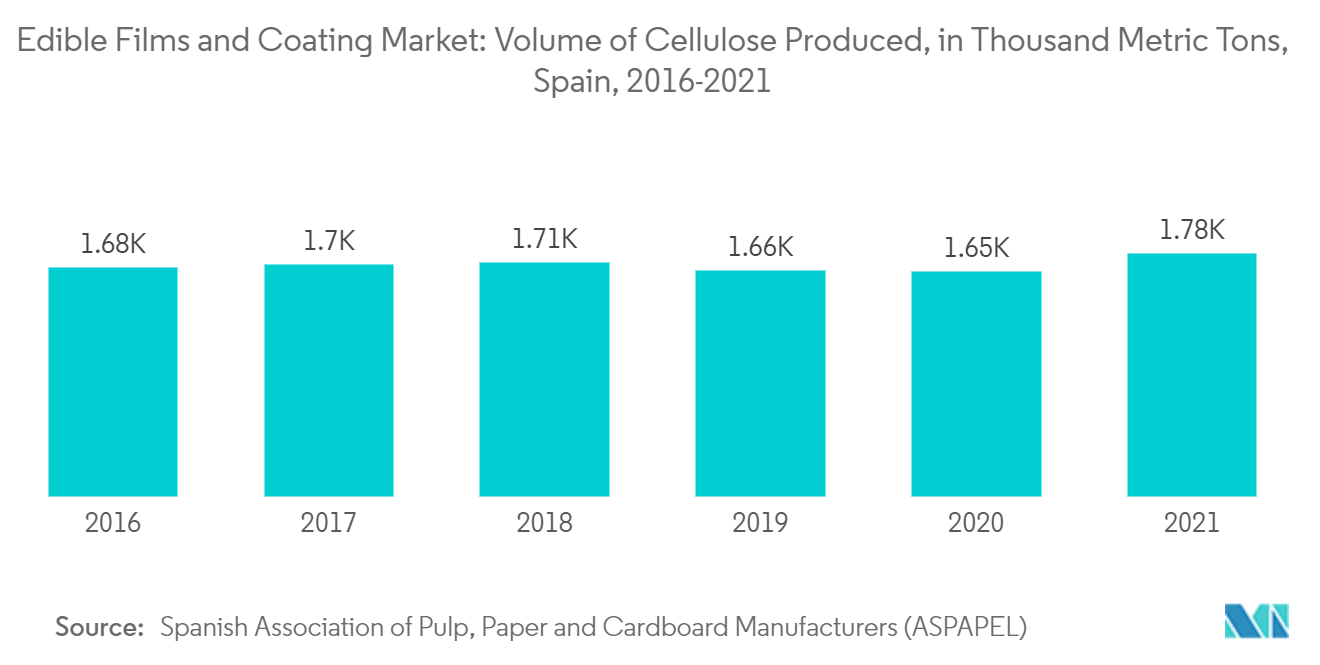
Asia-Pacific Continues to Dominate the Global Market
- China and Japan are the major consumers of the region's edible films and coatings market. In China, xanthan gum is one of the most commonly used edible coatings in food products, giving rise to the high demand for polysaccharide-based films and coatings.
- However, research to discover other sources of edible coatings is being conducted in the region, which is expected to extend the shelf life and prolong the freshness of products. Moreover, the rising awareness in countries like India is projected to lead to a very promising market scenario in the forecast period.
- In April 2021, BASF launched Joncryl HPB (High-Performance Barrier) in Hong Kong. According to the firm, this specific product is a water-based liquid barrier coating that plays an important role in the latest packaging trends and the conservation of natural resources. The strategy behind this new launch was to expand the company's business.
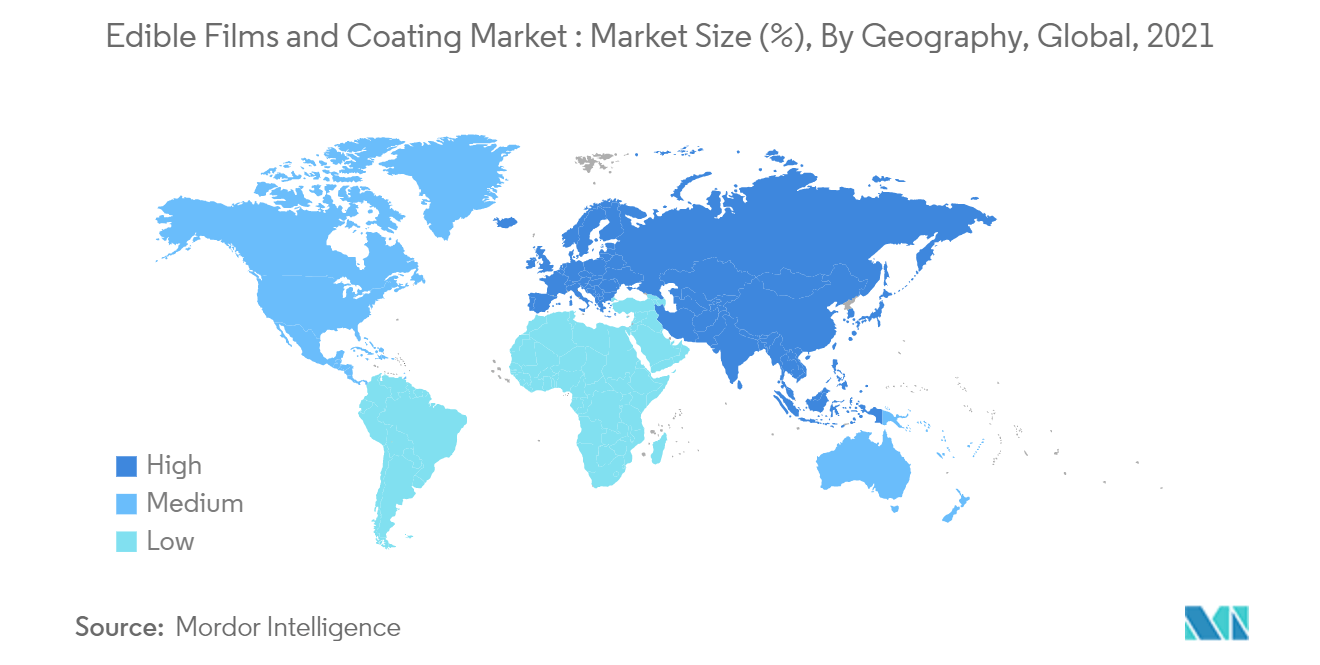
Competitive Landscape
The edible films and coating market is fragmented with global and regional market players. The major players operating in the edible films and coatings market include DuPont de Nemours Inc, Tate & Lyle, Cargill, Incorporated, Koninklijke DSM N.V., and Ingredion Incorporated. Edible film and coatings are a growing market within the packaging segment, where the demand is expected to upscale as consumers seek such options from their regular consumables. The market is poised to witness more innovations over the coming years, and the industry may expect mergers and acquisitions. New brands have emerged recently and have gained significant traction based on their offerings.
Edible Films and Coating Industry Leaders
-
Tate & Lyle PLC
-
Cargill, Incorporated
-
DuPont de Nemours Inc.
-
Koninklijke DSM N.V.
-
Ingredion Incorporated
- *Disclaimer: Major Players sorted in no particular order
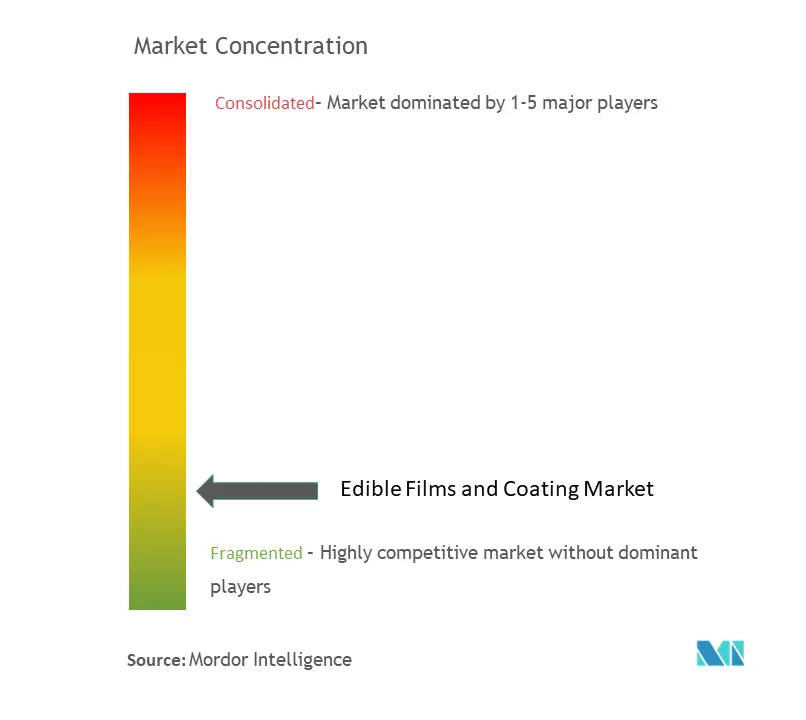
Recent Industry Developments
- In January 2022, In the United States, Akorn Technology announced the commercial launch of its edible coatings for fresh produce. Akorn's smart and multi-functional edible food coatings double the shelf life of most fruits and vegetables, minimize cold chain losses by 30% or more and provide products with better flavor, texture, and appearance.
- In November 2021, Sufresca, an Agri-Tech Startup, launched an edible coating that is a biodegradable, water-based emulsion that is made entirely of natural food ingredients and built with advanced modified atmosphere properties.
- In February 2021, Vita Fresh, an Agrofresh Solutions Inc. subsidiary, launched plant-based edible coatings for fresh produce. The produced coatings are sustainable and created using certified ISO14001 "Environmental Management System" standards. The coatings reduce dehydration, lock moisture in the products, and keep the food fresh for a longer time.
Global Edible Films and Coating Market Report Scope
Edible films and coatings are thin layers of edible materials applied to food products that play an important role in their conservation and distribution. Some of their functions are to protect the product from chemical and microbiological activities.
The edible films and coating market is segmented into ingredient type, application, and geography. Based on ingredient type, the market is segmented into protein, polysaccharides, lipids, and composites. Based on application, the market is segmented into dairy products, bakery and confectionery, fruits and vegetables, meat, poultry and seafood, and other applications. By geography, the market is segmented into North America, Europe, Asia-Pacific, South America, and the Middle East and Africa.
For each segment, the market sizing and forecasts have been done on the basis of value (USD million).
| Protein |
| Polysaccharides |
| Lipids |
| Composites |
| Dairy products |
| Bakery and Confectionery |
| Fruits and Vegetables |
| Meat, Poultry, and Seafood |
| Other Applications |
| North America | United States |
| Canada | |
| Mexico | |
| Rest of North America | |
| Europe | United Kingdom |
| Germany | |
| France | |
| Italy | |
| Spain | |
| Rest of Europe | |
| Asia-Pacific | India |
| China | |
| Japan | |
| Australia | |
| Rest of Asia-Pacific | |
| South America | Brazil |
| Argentina | |
| Rest of South America | |
| Middle-East and Africa | South Africa |
| Saudi Arabia | |
| Rest of Middle-East and Africa |
| Ingredient Type | Protein | |
| Polysaccharides | ||
| Lipids | ||
| Composites | ||
| Application | Dairy products | |
| Bakery and Confectionery | ||
| Fruits and Vegetables | ||
| Meat, Poultry, and Seafood | ||
| Other Applications | ||
| Geography | North America | United States |
| Canada | ||
| Mexico | ||
| Rest of North America | ||
| Europe | United Kingdom | |
| Germany | ||
| France | ||
| Italy | ||
| Spain | ||
| Rest of Europe | ||
| Asia-Pacific | India | |
| China | ||
| Japan | ||
| Australia | ||
| Rest of Asia-Pacific | ||
| South America | Brazil | |
| Argentina | ||
| Rest of South America | ||
| Middle-East and Africa | South Africa | |
| Saudi Arabia | ||
| Rest of Middle-East and Africa | ||
Key Questions Answered in the Report
How big is the Edible Films and Coating Market?
The Edible Films and Coating Market size is expected to reach USD 3.57 billion in 2025 and grow at a CAGR of 7.64% to reach USD 5.16 billion by 2030.
What is the current Edible Films and Coating Market size?
In 2025, the Edible Films and Coating Market size is expected to reach USD 3.57 billion.
Who are the key players in Edible Films and Coating Market?
Tate & Lyle PLC, Cargill, Incorporated, DuPont de Nemours Inc., Koninklijke DSM N.V. and Ingredion Incorporated are the major companies operating in the Edible Films and Coating Market.
Which is the fastest growing region in Edible Films and Coating Market?
South America is estimated to grow at the highest CAGR over the forecast period (2025-2030).
Which region has the biggest share in Edible Films and Coating Market?
In 2025, the Asia Pacific accounts for the largest market share in Edible Films and Coating Market.
What years does this Edible Films and Coating Market cover, and what was the market size in 2024?
In 2024, the Edible Films and Coating Market size was estimated at USD 3.30 billion. The report covers the Edible Films and Coating Market historical market size for years: 2019, 2020, 2021, 2022, 2023 and 2024. The report also forecasts the Edible Films and Coating Market size for years: 2025, 2026, 2027, 2028, 2029 and 2030.
Page last updated on:
Edible Films and Coating Market Report
Statistics for the 2025 Edible Films and Coating market share, size and revenue growth rate, created by Mordor Intelligence™ Industry Reports. Edible Films and Coating analysis includes a market forecast outlook for 2025 to 2030 and historical overview. Get a sample of this industry analysis as a free report PDF download.
